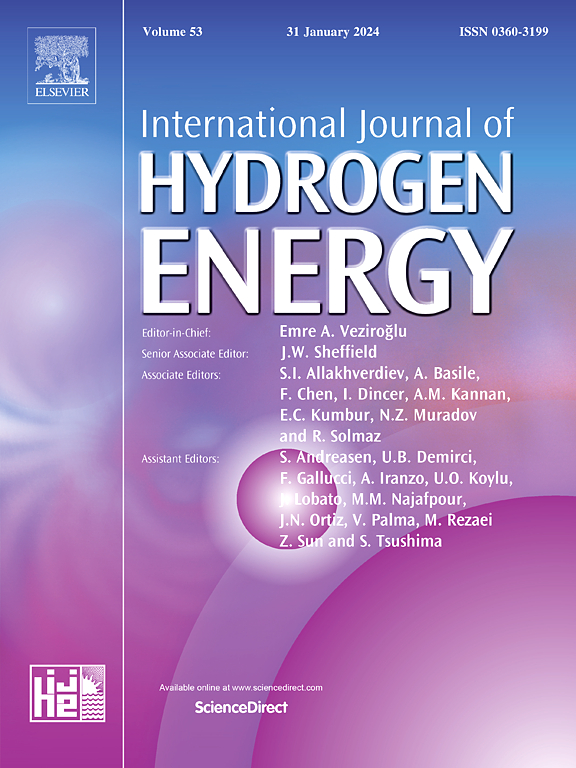金属铀中氢致点蚀的原子尺度起源:铀晶界氢行为的第一性原理研究
IF 8.3
2区 工程技术
Q1 CHEMISTRY, PHYSICAL
引用次数: 0
摘要
金属铀氢化腐蚀具有点状分布特征,并优先发生在晶界处。为探索氢在金属铀晶界特殊行为的内在机理,采用基于密度泛函理论的第一性原理方法,系统研究了氢在铀晶界的溶解、偏析和扩散行为,以及氢对晶界强度的影响。计算分析表明,晶界能越大,晶界处氢原子的总溶解能越小,偏析能越小,俘获能力越强。晶界结构对氢原子的溶解和偏析有重要影响。氢原子倾向于在晶界区域内水平扩散,这使得氢原子很难从晶界区域扩散到晶粒内部。铀原子的6d轨道和氢原子的1s轨道在晶界上发生轨道杂化,氢原子和铀原子之间的电荷转移可以反映它们相互作用的强度。氢原子在晶界处的溶解降低了它们的强度,使它们更容易脆化。氢原子对铀铀键强度的弱化作用是氢原子引起晶界脆化的根本原因。本文从微观机理角度揭示了氢在铀晶界处的行为,为理解金属铀的加氢腐蚀特性和耐腐蚀方法提供了理论支持。本文章由计算机程序翻译,如有差异,请以英文原文为准。
Atomic scale origin of hydrogen induced pitting corrosion in metallic uranium: first principles study of hydrogen behavior at uranium grain boundaries
Metal uranium hydrogenation corrosion has a point like distribution characteristic and occurs preferentially at grain boundaries. To explore the intrinsic mechanism of hydrogen's special behavior at metal uranium grain boundaries, a first principles method based on density functional theory was used to systematically study the solution, segregation, and diffusion behavior of hydrogen at uranium grain boundaries, as well as the influence of hydrogen on grain boundary strength. The calculation analysis shows that the larger the grain boundary energy, the smaller the overall solution energy of hydrogen atoms at the grain boundary, the smaller the segregation energy, and the stronger the capture ability. The grain boundary structure has a significant impact on the dissolution and segregation of hydrogen atoms. Hydrogen atoms tend to diffuse horizontally within the grain boundary region, making it difficult to diffuse from the grain boundary region to the interior of the grain. The 6d orbitals of uranium atoms and the 1s orbitals of hydrogen atoms on grain boundaries undergo orbital hybridization, and the charge transfer between hydrogen and uranium atoms can reflect the strength of their interaction. The solution of hydrogen atoms at grain boundaries reduces their strength and makes them more prone to embrittlement. The weakening effect of hydrogen atoms on the strength of uranium uranium bonds is the fundamental reason for the embrittlement of grain boundaries caused by hydrogen atoms. This article reveals the behavior of hydrogen at uranium grain boundaries from a microscopic mechanism perspective, providing theoretical support for understanding the hydrogenation corrosion characteristics and corrosion resistance methods of metallic uranium.
求助全文
通过发布文献求助,成功后即可免费获取论文全文。
去求助
来源期刊

International Journal of Hydrogen Energy
工程技术-环境科学
CiteScore
13.50
自引率
25.00%
发文量
3502
审稿时长
60 days
期刊介绍:
The objective of the International Journal of Hydrogen Energy is to facilitate the exchange of new ideas, technological advancements, and research findings in the field of Hydrogen Energy among scientists and engineers worldwide. This journal showcases original research, both analytical and experimental, covering various aspects of Hydrogen Energy. These include production, storage, transmission, utilization, enabling technologies, environmental impact, economic considerations, and global perspectives on hydrogen and its carriers such as NH3, CH4, alcohols, etc.
The utilization aspect encompasses various methods such as thermochemical (combustion), photochemical, electrochemical (fuel cells), and nuclear conversion of hydrogen, hydrogen isotopes, and hydrogen carriers into thermal, mechanical, and electrical energies. The applications of these energies can be found in transportation (including aerospace), industrial, commercial, and residential sectors.
 求助内容:
求助内容: 应助结果提醒方式:
应助结果提醒方式:


